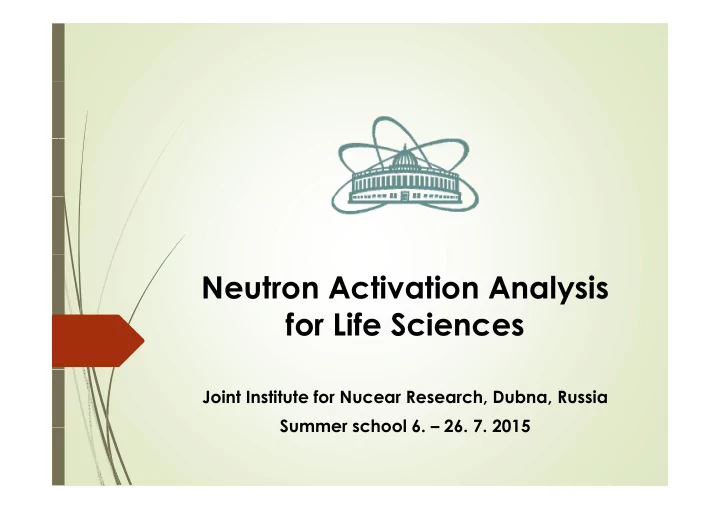

Neutron Activation Analysis for Life Sciences Joint Institute for Nucear Research, Dubna, Russia Summer school 6 – 26 7 2015 Summer school 6. – 26. 7. 2015
P Project participants j t ti i t 2 Iustinian Mihail Focsa, Unive rsity o f Buc hare st, RO Milan Žák Cze c h T Milan Žák, Cze c h T e c hnic al Unive rsity Prague CZ e c hnic al Unive rsity, Prague , CZ Ji ř í Janda, Unive rsity o f De fe nc e , Brno , CZ Lucie Fišerová Unive rsity o f De fe nc e Brno CZ Lucie Fišerová, Unive rsity o f De fe nc e , Brno , CZ Zuzana Fedi č ová, VŠB – T e c hnic al Unive rsity, Ostrava, CZ Veselina Georgieva Plo vdiv Unive rsity Paisii Hile ndarski BG Veselina Georgieva, Plo vdiv Unive rsity Paisii Hile ndarski, BG Project supervisor: Project supervisor: Prof Marina V Frontasyeva Prof. Marina V. Frontasyeva Laboratory: Frank Laboratory of Neutron Physics
Ai Aim of the project f th j t 3 Theoretical lectures focused on neutron physics Reactor shutdown => Basic methods of sample preparation and packing Mosses, grass, corals Spectra evaluation of preirradiated samples Genie 2000 (Canberra, USA)
C Content of presentation t t f t ti 4 NAA introduction Types of NAA Technique procedure Sampling Sa p g Sample preparation Irradiation Irradiation Measurement Spectra processing and evaluation Spectra processing and evaluation Interpretation Summary Summary
NAA I t NAA - Introduction d ti 5 isotope specific analytical technique for the qualitative lit ti and d quantitative tit ti determination d t i ti of f elemental content conversion of stable atomic nuclei into radioactive conversion of stable atomic nuclei into radioactive nuclei by irradiation with neutrons and the subsequent detection of the gamma radiation emitted during the decay of these radioactive emitted during the decay of these radioactive nuclei
6
f NAA Types of NAA T 7
8 Instrumental NAA (non-destructive), large sample NAA Radiochemical NAA (destructive), re quire s sample pre paratio n
Biomonitoring Biomonitoring 9 UNECE ICP UNECE ICP Vegetation Vegetation Bio- Bio -nano nano Environment Environment Environment Environment technology technology Life Life Medicinal Medicinal Geology Geology Geology Geology Sciences Sciences plants plants Food Food Cosmos Cosmos products products Antropology Antropology
10
T Technique procedure h i d 11 1. Sampling (collecting, tagging, bagging) 2. Sample preparation (drying, dissolving, crushing, moulding, etc.) 3. Irradiation (IBR 2) 4. 4. Measurement (REGATA) Measurement (REGATA) 5. Spectra analysis, interpretation
1. Sampling li 1 S 12
2. Sample preparation ti l 2 S 13
2. Sample preparation ti l 2 S 14
3 I 3. Irradiation at IBR-2 di ti t IBR 2 15 Transport capsules for irradiation irradiation Ch1-Ch4 –irradiation channels, S- intermediate storage, DCV- directional control valves, L- loading unit, RCB- radiochemical glove-cell, U- unloading unit, SU- separate unit, SM- storage magazine, R- repacking unit, D- t it SM t i R ki it D d t detector, CB- control t CB t l board, R1-R3- the rooms where the system is located.
N Neutron sources t 16 Isotope neutron sources (Cf 252 AmBe PuBe) Isotope neutron sources (Cf-252, AmBe, PuBe) Neutron generators (IREN at JINR) Nuclear and research reactors (IBR 2 LVR 15 in Nuclear and research reactors (IBR-2, LVR-15 in Rez, CZ)
4 M 4. Measurement (REGATA) t (REGATA) 17
4 M 4. Measurement (REGATA) t (REGATA) 18
5 S 5. Spectra analysis t l i 19
6. Interpretation t ti 6 I t 20
Summary 21 Pros: Simultaneous qualitative/quantitative multi- element analysis Mostly non-destructive and relative quick No contamination of workplace and laboratory Minimum need of chemical reagents Cons: Necessity of knowledge of sample matrix Neutron source special regulation, safety rules and radiation protection Dealing with radioactive waste Not all elements can be detected Interferences
Thank you for your attention! 22
Recommend
More recommend